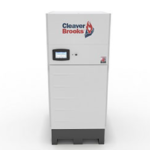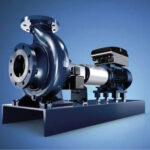Gas Technology: Condensing Hydronic Boilers
 Depending on the return water temperatures being above or below 140° F will influence the need for a near-condensing versus non‐condensing boiler.
Depending on the return water temperatures being above or below 140° F will influence the need for a near-condensing versus non‐condensing boiler.
Getting the most for your energy dollar
Condensing hydronic boilers can operate at efficiencies in the mid‐90s and above. The key to these fantastic efficiencies is having incoming feedwater at temperatures below 140° F and to be able to either modulate the boiler or have sufficient redundancy that operating units can be held near their efficiency “sweet spot.”
Extract More Heat from Combustion Exhaust
Hydronic boilers can be used for either building heat or for process hot water applications. The condensing boiler extracts latent heat, in addition to sensible heat, from combustion exhaust. For new natural gas‐fired units, the efficiency difference is typically about 10% higher. This presumes that the return water is low enough in temperature to permit a high level of condensation from the combustion exhaust.
Efficiencies as High as 97%
Cleaver‐Brooks is one of the leaders in the manufacture of condensing hydronic boilers. Duane Rolkosky, Regional Vice President of the firm was a recent presenter at a Technology and Market Assessment Forum sponsored by the Energy Solutions Center. In his presentation he demonstrated that with a 130° F single return water flow, the boiler could achieve efficiencies as high as 90%. By using a dual return with 90% of the return flow at 150° F and 10% at 80° F, efficiencies as high as 97% were achievable. The 80° F portion of the flow helped achieve the nearly‐complete condensation of water in the combustion exhaust.
Another Cleaver‐Brooks spokesperson, Alan Wedal, Product Manager – Packaged Boilers, indicates there is growing acceptance of the condensing hydronic boiler in the marketplace. “The order entry level for our condensing units has remained strong and continued to increase significantly over the last three years. Certain areas of the country have adopted this technology more strongly than others.” He feels that the influences on growing adoption of the technology are incentives and rebates, design engineer experience, and owner knowledge.
Alufer Tube for Better Heat Exchange
A relatively recent introduction by Cleaver‐Brooks is their ClearFire Condensing unit. Wedal notes that the patented Alufer tube in this unit greatly increases the heat transfer surface area and also allows a higher heat transfer coefficient through the use of aluminum alloy fins, and a design to keep the flue gas flow turbulent through the entire length of the tube.
Wedal notes that many owners are experiencing a 20% to 30% reduction in fuel consumption by replacing older boilers with newer units. He points out, “This is happening in some cases even without the use of condensing boilers, due to more efficient unit designs, and to firing modulation becoming standard on many units.” He emphasizes that with the use of condensing boilers, the reduction can be even more dramatic. “We have seen up to a 50% reduction in energy use in systems that make proper use of outdoor reset schedules, aggressive night/weekend setback schemes and larger system temperature differentials.”
Combine Condensing with Non‐Condensing
Wedal discusses the paybacks available with boiler replacement. “This will depend on the quantity and type of boilers replaced. We have seen typical payback times to be around five years.” However, he explains that with the design of hybrid boiler plants – condensing and modern non‐condensing boilers together – payback times sometimes drop to as low as two years. “The smaller initial investment can still return near the same energy reduction, so the payback is shorter and the ROI is higher.”
Wedal cautions that not all applications are suitable for a condensing hydronic boiler. “While a condensing boiler can be used to replace almost any boiler or be used in new applications, there is a cost premium to manufacture a boiler that can withstand the effects of the acid condensate formed during the condensing action. If an application will never see return water temperatures low enough to cause condensing in the boiler, a better choice would be to use a near‐condensing boiler. At return water temperatures at or above 140° F, the condensing boiler and the near‐condensing boiler will have approximately the same efficiency but the latter will have a lower initial cost.”
Read the full article on the Control Engineering website.
Source: The Energy Solutions Center




